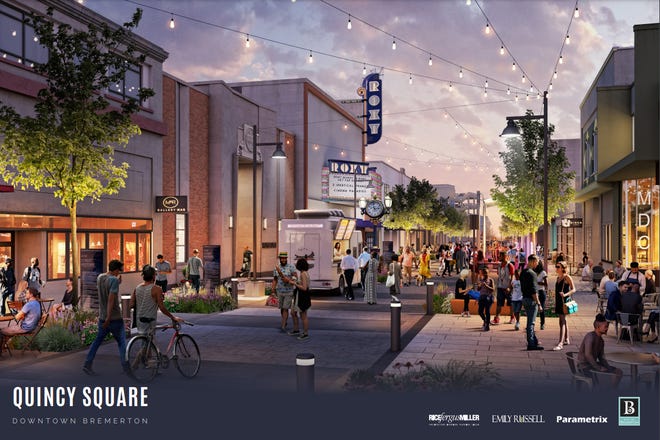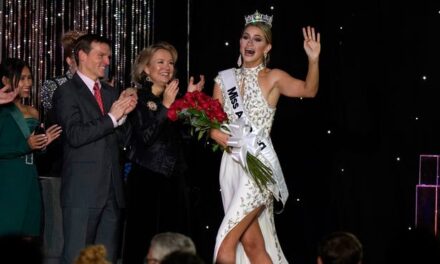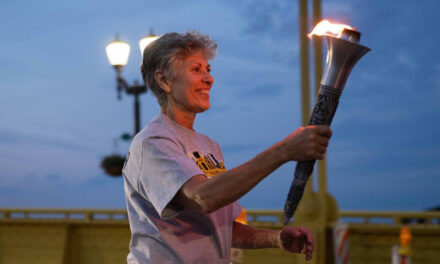
Harriette Bryant delivered a special birthday present for producer, songwriter and composer Quincy Jones – a Washington State Legacy Project book written about Bremerton civil rights activist Lilian Walker that featured a section about Jones himself.
Bryant, interim executive director of the YWCA and founder of the Our GEMS nonprofit, gave the book to Jones through his half-brother, Washington State Supreme Court Justice Richard, who lives in Seattle, to pass along. Jones sent back a photo of himself reading the book, excited and amazed that he was included it and that his old home town remembered him.
Jones’ family moved to Bremerton from Chicago in 1943 and lived in the segregated Sinclair Heights to work on the Puget Sound Naval Shipyard, well before he’d won 28 Grammy Awards and produced best-selling hits like “We Are the World” and “Thriller.” As the story goes, he told late-night talk show host Stephen Colbert in 2016, after breaking into the Bremerton Armory at 11 years old he met his first piano, and “Every cell in my body and every drop of blood told me this is what I would be doing for the rest of my life.”
Bryant was also part of the team that delivered special T-shirts along with project designs set in beautiful frames to Jones in the same manner, to ask for his approval of the proposed Quincy Square project on Fourth Street, envisioned to pays homage to the humble beginning of his launch into stardom and commemorate Jones as part of Bremerton’s rich history of African American influence.
With Jones’s blessing, Quincy Square is now aimed to revitalize Fourth Street from Pacific Avenue to Washington Avenue, and establish a district focused on arts, entertainment, evening-centric retail spaces and a Musical Discovery Center. The $5.5 million project is going out to bid for a contractor in coming months before construction is anticipated to start in the spring. In the meantime, the city has put out a call for artists to creatively memorialize the diaspora of African American history Jones and others have been a part of.
City’s call for downtown sculpture and murals
“We have a designer who’s doing the street part of it, but if we really do want to give Quincy Square heart and soul, it needs to come from that community,” said Katie Ketterer, project manager for Quincy Square. “So, we split off some of the more artistic elements of the project and brought in the Bremerton Arts Commission to help us come up with some committees that would define what the art should be like, the goals of the art, type of art and to select those artists that will execute the art.”
The Bremerton Arts Commission has issued artist calls for a sculpture on the southeast corner of Pacific Avenue at Fourth Street, and a mural and site specific art on the parking garage on Washington Avenue. Artists can apply until December 10.
The focus of these pieces should be “the celebration of the African American pioneers that’s been here – we’re asking the artists to capture their spirit,” committee member Roosevelt Smith said, mentioning significant Black Bremerton residents like Lillian Walker, Nathanial Sargeant and Jane Ruley. “Our scope is to highlight what Quincy Jones stands for and that’s the collaboration of everyone because his music spans all genres. There was no boundaries.”
The artwork “will depict the history of Bremerton,” Mayor Greg Wheeler said. “You’re going to see it share the different parts in our history that our City’s not proud of – it’ll be redlining, it could be segregation and where African Americans were in Sinclair Heights.”
Recognition for city’s African American heritage
Art has been an important vehicle to preserve history for African Americans and their ancestors, said Bryant, who is on the sculpture committee, mentioning Augusta Asbury’s portraits of dancing Black women.
“Quincy loves music and we can all come together when it comes to music,” Bryant said. “It’s not just for a particular culture, but I do expect for our culture to be recognized. Please don’t cut us out. We want to be inclusive and we want everyone to be able to share exactly what we’re trying to do here in downtown Bremerton. It’s huge for us – it’s huge for the whole community to come together and be on one accord and enjoy our beautiful downtown.”
Though the artistic ambitions for Quincy Square aspire for recognition, they are wading upstream through a long history of the erasure of African American voices.
“When you look at the history of Kitsap, it’s never the Black community,” said Bryant. “When you go back to the history, we’re in there, but it’s never showcased. And so with this opportunity with Quincy Square, we’re hoping that that would be the case (that Black history would be recognized) because amplifying Black voices means acknowledging our history here. Black history is very important and we shouldn’t have to work so hard to be recognized.”
Smith remembers reading a book on the history of Kitsap County from the 1970s and noticing that there were only two references to African Americans, until later revisions. During World War II, when the Puget Sound Navy Yard recruited nearly 80,000 workers to meet wartime production demands, 10,000 African Americans arrived in Bremerton, many of whom were assigned to segregated housing in Sinclair Heights – Jones’ family among them. From 1940 to 1945, the African American population grew from less than 100 to over 4,500, but local archived history made no mention.
“We had been erased completely from the history of Bremerton,” Smith said.
In the early days of the Quincy Square project, African American community leaders criticized the project for a lack of diverse representation guiding the project.
A call and response for inclusion in Bremerton
While discussing plans for the Living Arts Cultural Heritage Center museum in the Marvin Williams Recreation Center in 2014, African American community leaders discussed ideas for cultural tourism in Bremerton, coupled with the legacy of Quincy Jones, to preserve the history of African Americans in Kitsap County from pioneers to shipyard workers, said historian and civil rights activist Akuyea Karen Vargas. But Vargas said the city began working on Quincy Square without the inclusion of many of those same community members.
“When you were talking about centering our local African American history and heritage, and when those communities brought the project forward and then they were erased from that process, it really damaged relationships,” Vargas said.
The idea to activate the stretch of Fourth Street and make it a downtown center came from a brainstorming of downtown business owners and community members, Ketterer said. These ambitions were then joined by the Fourth Street Action Group’s ideas to center the project around Quincy Jones following his appearance on The Late Show with Colbert.
“A couple things kind of came together – one, how do we activate downtown and create this cultural center, and we needed to provide opportunity for cultural enrichment, an opportunity for entertainment, a way to unify our community and bring a voice to diversity,” Wheeler said. “My role was helping a community group transition into a partnership with local government where we could team with the community to provide the heart and the vision. The City could perform the fundraising through our grant expertise, our technical expertise in infrastructure, and workforce knowledge. We know how to go out and access money but the community helped shape this.”
Besides calling for more African American community leaders to be included in the process, Vargas hopes that African American businesses will be centered in Quincy Square so that they can be a part of the downtown revitalization instead of being exploited for cultural resources.
“All throughout it kind of seemed like the inclusion of African American voices was not there, there were opportunities for us to do collective, collaborative pieces,” Vargas said. “We wanted to know exactly how that would impact the African American community, the economic development, because we had that economic development piece, which was the cultural tourism piece.”
After African American community members called for more inclusion at a community meeting at the Roxy Theater in 2020, project leaders paused and took an opportunity to expand outreach, Wheeler said. “It was just to pause and be more inclusive because the idea was that we wanted everybody to be heard and be satisfied that they had been heard.”
The city and design team launched a series of outreach meetings and issued invitations to more people of color and African American community members for input.
“In the citizens committee, we have so many community people that are involved in this to make sure that the Black voice is heard,” Smith said. “Initially, there was a feeling that, wow, this project is being hijacked one more time, because historically, this happens, but what the City did, I have to salute.”
While Vargas retains some reservations, she also supports Quincy Square and sees it as an opportunity “to be able to heal forward in a way that we can begin to start rebuilding relationships, rebuilding the trust and in a way to strengthen us as we work in a collective, collaborative way versus in our silos.”
As the project gets closer and closer to breaking ground, Bryant thinks of Jones, who is now 90 years-old.
“He’s getting older and I’m just hoping that he’ll be able to see the end result and to see the beautiful artwork that’s going up for Quincy Square,” Bryant said. “I just don’t think anybody’s ever done anything like this during his era. We’re hoping that once this project is done, we all can come together and just celebrate.”




